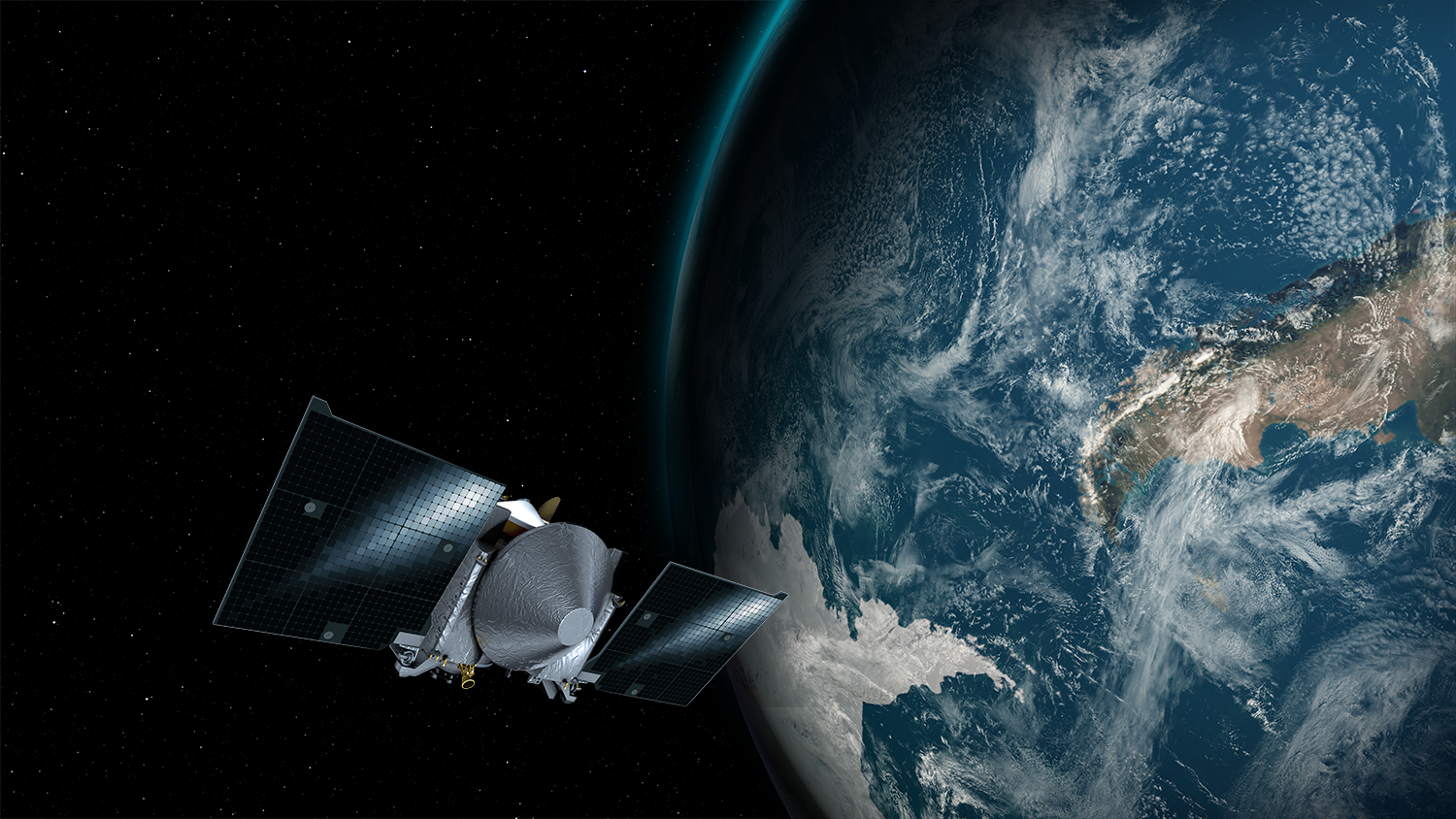NASA’s asteroid sample return mission, OSIRIS-REx (Origins, Spectral Interpretation, Resource Identification, and Security – Regolith Explorer), will pass about 11,000 miles (17,000 kilometers) above Earth just before 12:52 p.m. EDT on Friday, Sept. 22. Using Earth as a slingshot, the spacecraft will receive an assist to complete its journey to the asteroid Bennu.
OSIRIS-REx is undertaking a challenging mission to visit the near-Earth asteroid, survey the surface, collect samples and deliver them safely back to Earth. This is the first NASA mission to attempt such an undertaking. The spacecraft is halfway through its two-year outbound journey, and now OSIRIS-REx needs an extra boost to successfully rendezvous with Bennu.
Bennu’s orbit around the Sun is tilted six degrees in comparison to Earth’s. The gravity assist will change OSIRIS-REx’s trajectory to put the spacecraft on a course to match the asteroid’s path and speed.
“The Earth Gravity Assist is a clever way to move the spacecraft onto Bennu’s orbital plane using Earth’s own gravity instead of expending fuel,” said Dante Lauretta, OSIRIS-REx principal investigator at the University of Arizona, Tucson.
The team has already made multiple adjustments to the spacecraft’s path since launch on Sept. 8, 2016. The largest was a deep space maneuver on Dec. 28, 2016, that changed the speed and path of the spacecraft to target Earth for the flyby. There have also been three trajectory correction maneuvers – one on Oct. 7, 2016, one on Jan. 18, 2017, and another on Aug. 23, 2017 (30 days before the gravity assist) – that further refined the spacecraft’s trajectory in preparation for the flyby.
The navigation team comprises employees from NASA’s Goddard Space Flight Center in Greenbelt, Maryland, and KinetX Aerospace. KinetX Aerospace navigation team members plan and carry out all OSIRIS-REx maneuvers with the Lockheed Martin spacecraft operations team at the Lockheed Martin Waterton Campus in Littleton, Colorado. To properly target the Earth Gravity Assist, the navigation team calculates any required amount of change in the spacecraft’s course and speed. This information is then translated by the operations team into commands that are uploaded to the spacecraft and executed by firing the spacecraft’s rocket engines.
After traveling almost 600 million miles, OSIRIS-REx will approach Earth at a speed of about 19,000 mph. The spacecraft will fly over Australia before reaching its closest point to Earth over Antarctica, just south of Cape Horn, Chile.
“For about an hour, NASA will be out of contact with the spacecraft as it passes over Antarctica,” said Mike Moreau, the flight dynamics system lead at Goddard. “OSIRIS-REx uses the Deep Space Network to communicate with Earth, and the spacecraft will be too low relative to the southern horizon to be in view with either the Deep Space tracking station at Canberra, Australia, or Goldstone, California.”
NASA will regain communication with OSIRIS-REx at 1:40 p.m. EDT, roughly 50 minutes after closest approach.
At 4:52 p.m. EDT, four hours after closest approach, OSIRIS-REx will begin science observations of Earth and the Moon to calibrate its instruments.
During the gravity assist, OSIRIS-REx will pass through a region of space that is inhabited by Earth-orbiting satellites, and NASA has taken precautions to ensure the safety of the spacecraft as it flies through this area. The mission’s flight dynamics team designed a small maneuver that, if necessary, could be executed a day before closest approach to change the spacecraft’s trajectory slightly to avoid a potential collision between OSIRIS-REx and a satellite.
“A few weeks after the flyby we will assess the outgoing trajectory on its way to Bennu,” said Dan Wibben, the maneuver design and trajectory analysis lead from KinetX Aerospace. “There is a maneuver planned in case we need to adjust the orbit just a little bit to push the spacecraft back on track.”
In late June of 2018, the team will perform another deep space maneuver to further target the rendezvous with Bennu. Then beginning in October 2018, a series of asteroid approach maneuvers will be executed to slow the spacecraft with respect to the asteroid.
Once OSIRIS-REx rendezvous with Bennu in late 2018, the spacecraft will begin surveying the surface.
“The asteroid’s small size and low gravity makes OSIRIS-REx the most challenging mission that I have worked on,” said Peter Antreasian, the navigation team chief from KinetX Aerospace. “At roughly 500 meters in diameter, Bennu will be the smallest object that NASA has orbited.”
While the engineering team is busy carrying out the Earth Gravity Assist, the mission invites members of the public to mark the occasion by participating in the Wave to OSIRIS-REx social media campaign. Individuals and groups from anywhere in the world are encouraged to take photos of themselves waving to OSIRIS-REx, share them using the hashtag #HelloOSIRISREx and tag the mission account in their posts on Twitter (@OSIRISREx) or Instagram (@OSIRIS_REx).
Participants may begin taking and sharing photos at any time—or wait until the OSIRIS-REx spacecraft makes its closest approach to Earth at 12:52p.m. EDT on Friday, Sept. 22.
NASA’s Goddard Space Flight Center provides overall mission management, systems engineering and the safety and mission assurance for OSIRIS-REx. Dante Lauretta of the University of Arizona, Tucson, is the principal investigator, and the University of Arizona also leads the science team and the mission’s science observation planning and data processing. Lockheed Martin Space Systems in Denver built the spacecraft and is providing flight operations. Goddard and KinetX Aerospace are responsible for navigating the OSIRIS-REx spacecraft. OSIRIS-REx is the third mission in NASA’s New Frontiers Program. NASA’s Marshall Space Flight Center in Huntsville, Alabama, manages the agency’s New Frontiers Program for its Science Mission Directorate in Washington.
For more information about the OSIRIS-REx mission, visit:
By Jordan Rice
NASA’s Goddard Space Flight Center, Greenbelt, Md.

























